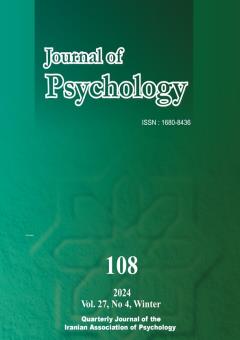Psychometric Properties Of Bender – Gestalt(II) Test In Primary School Students
Subject Areas : روانسنجی
mehdi arabzadeh
1
![]() ,
alireza joshany
2
*
,
alireza joshany
2
*
![]()
1 - Educational Psychology in, KHU, Iran, Tehran
2 - Faculty of Psychology and Educational Sciences, Azad University, Tehran Central Branch, Tehran, Iran
Keywords: validity, reliability, Bender Gestalt(II) test,
Abstract :
Visual-Motor skill is essential for human development and an important part of psychological evaluations and allows a person to have sufficient interaction with her environment. In order to measure this important skill, it is better to use an objective and standard tool. Since for each psychological assessment tool, it is necessary to check the psychometric properties. The aim of the current research is to investigate the psychometric properties of B.G.V.M.T (2) in students aged 6 to 12 years. The current research was applied in terms of objective and descriptive research method of correlation type. The statistical population of the present study included all primary school students in the 4 educational districts of Qom in the academic year 1400-1401, which were selected by multi-stage cluster sampling, 374 girls and 444 boys from 8 schools. For the reliability of the test, retesting and dividing methods were used. The reliability coefficient obtained from the retesting of the test in the copy and recall phases was 0.85 and 0.78, respectively, and the average reliability coefficient was 0.67. To measure the validity of the test from 3 methods[calculating the correlation coefficients between the test scores of B.G.T (2) and Andre Ray and the inclusive scoring system and Koppitz, comparing the performance of children with and without learning disorders] was used. In general, according to results of the reliability and validity research conducted in this research, we can consider the B.G.T (2) with a G.S.S as a useful tool for measuring V.M ability of children.
باقری، فتانه، و موسی پور، نعمت اله. (1392). توان آزمون بندرگشتالت در پیش بینی مشکلات دیکتهنویسی کودکان پیشدبستانی. پژوهشهای آموزش و یادگیری (دانشور رفتار)،20 (دوره جدید) (3)، 146 – 133.
بهرامیان، افروز؛ هادیانفرد، حبیب؛ محمدی، نوراله و رحیمی، چنگیز. (1392). هنجاریابی آزمون بندرگشتالت2 در کودکان 11-4 ساله شهر شیراز. فصلنامه اندازهگیری تربیتی، 4 (29) ، 188-165.
چگینی، مریم؛ دلاور، علی و غرایی، بنفشه. (1392). ویژگیهای روانسنجی پرسشنامه بالینی چند محوری میلون-3. فصلنامه پژوهشهای نوین روانشناختی، 8 (29).
حسنآبادی، حمیدرضا و ترابی، سیدسعید. (1402). ویژگی های روانسنجی مقیاس هیجانخواهی زاکرمن: عاملی برای پیشبینی اهمالکاری تحصیلی دانشجویان. مجله روانشناسی، 27 (3)، 273 – 263.
دلاور، علی (1389). مبانی نظری و عملی پژوهش در علوم انسانی و اجتماعی، تهران، انتشارات رشد.
شریفی، حسن پاشا. (1398). نظریه و کاربرد آزمونهای هوش و شخصیت، تهران، انتشارات سخن.
شریفی، حسن پاشا، حبیبی، مجتبی، فرزاد، ولی الله، رضاخانی، سیمین دخت، حسن آبادی، حمیدرضا و ایزانلو، بلال. (1391). پژوهش چندمتغیری کاربردی (طرح و تفسیر). تهران، انتشارات رشد.
طهماسبی، سیامک؛ مفاخری باشماق؛ سامان؛ عمادالدین، عاطفه و رضایی، راحله. (1394). هنجاریابی آزمون دیداری- حرکتی بندرگشتاات در گروه کودکان 7-4 ساله تهران، مجله توانبخشی، 17 (1).
فتحی آشتیانی، علی. (1392). آزمونهای روانشناختی، تهران، انتشارات بعثت.
کاوه فارسانی، ذبیح اله، نظریفر، محسن و محمودی نجف آبادی، فاطمه. (1402). ارزیابی رابطه بین ذهن آگاهی و کیفیت رابطه زناشویی با میانجی گری باورهای لذت بری و قدردانی. مجله روانشناسی، 27 (1) ، 9 – 1.
لطف آبادی، حسین. (1374). آزمونهای روانی- شناختی کودکان برای مشاوره کودک، مشهد، موسسه چاپ و انتشارات آستان قدس رضوی.
مهرینژاد، سید ابوالقاسم؛ صبحی قراملکی، ناصر و رجبی مقدم، سارا. (1391). بررسی توان پیش بینی آزمون بندرگشتالت برای آمادگی ابتلا به ناتوانیهای خواندن و دیکته در کودکان پیش دبستانی، مجله ناتوانیهای یادگیری، 1 (3) ، 130 – 118.
میرهاشمی، مالک و احدی، حسن. (1382). هنجاریابی مقدماتی آزمون درهم ری روی دانشآموزان 7 تا 18 ساله، مجله دانش و پژوهش در روان شناسی کاربردی، 17، 20-1.
نظری، سمیه؛ سیاحی، حیدری و افروز، غلامعلی. (1392). مقایسه ادراک دیداری- حرکتی کودکان دارای اختلال یادگیری و عادی در آزمون بندرگشتالت. مجله ناتوانیهای یادگیری، 2 (3) ، 135- 116.
هادیان فرد، حبیب. (1386). ساخت و هنجاریابی آزمون خط زنی (فرم فارسی) برای دانشآموزان دوره ابتدایی شهر شیراز. مجله علوم اجتماعی و انسانی دانشگاه شیراز. 26 (3) ، 209-193.
Brannigan, G., & Decker, S. L. (2003). Visual Motor Gestalt Test: Examiner’s manual, Bender Gestalt II: Bender, 2nd ed, c2003.
Brannigan, G., & Decker, S. L. (2006). The Bender-Gestalt II. American Journal of Orthopsychiatry. 76 (1), 10 – 12.
Groth-Marnat, G., Wright, A, J. (2016). Handbook of Psychological Assessment, 6th ed.
Keppeke, L. F., Cintra, I. P., & Schoen, T. H. (2013). Bender Visual-Motor Gestalt Test in adolescents: relationship between Visual-Motor Development and the tanner stages. Perceptual & Motor Skills. (117), 257- 275.
Noronha, A. P. P., Santos, A. A. A., Rueda, F. J. M., Otoni, F., Ferraz, A. S., Costa, A. R. L., Zuanazzia, A. C., & Jesuino, A. D. S. A. (2020). Correction systems of the Bender Visual - Motor Gestalt Test: A systematic mapping of the literature. Liberabit, 26 (2), e392, Julio-Diciembre, ISSN: 1729-4827 2223-7666.
Ozgur, H. (2020). Relationship between teacher’ technostress, technological pedagogical content knowledge (TRACK), school support and demographic variables: A structural equation modeling. Computers in human behavior. (112), 1 – 9.
Rueda, F. J. M., & Jesuino, A. D. S. A. (2018). The Bender Gradual Scoring System for Assessment of People with Intellectual Disabilities. Paidéia. (28), e2807.
Strait, J. E., Wright, E. K., & Decker, S. L. (2018). Bender-Gestalt II differential item functioning across Caucasian and African American examinees. Psychol Schs. (56), 148 – 158.
Tafti, M. A., Azizi, Z. R., & Mohamadzadeh, S. (2021). A comparison of the diagnostic power of FEATS and Bender - Gestalt test in identifying the problems of students with and without specific learning disorders. The Arts in Psychotherapy. (73), 1-7.

